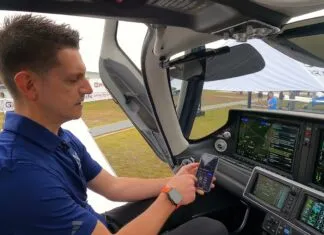The hackneyed aphorism about what happens between cup and lip aptly describes the state of the recently passed Third Class medical exemption. Signed into law in July amidst much cheering by industry groups, the proposed new medical rule lacks just one thing: Certainty, especially for pilots who currently have special issuances.
While the bill’s author, Sen. Jim Inhofe, made the law’s language as specific as possible to favor minimal FAA intervention, the agency may still have room to add conditions and requirements in the final rule it’s required to publish within 180 days of enactment. “The fact is, we just don’t know what the FAA will do,” one senior AME told us in late July. Nonetheless, the bill’s language and intent are clear and even those worried about FAA fiddling in the margins believe it will still benefit thousands of pilots who otherwise couldn’t pass medical certification or who worry that they would be disqualified as they suffer age-related conditions.
Hard Fought
Officially called the Third Class Medical Reform and General Aviation Pilot Protections, the bill finally oozed through Congress as part of a continuing resolution to fund the FAA. That improved its chances of passage, but it also required dropping some provisions that would have essentially all but eliminated any kind of medical certification for pilots who now require a Third Class medical. President Obama signed the measure into law on July 15, which sets the clock ticking on a 10-year look back on medical eligibility. The sidebar on the opposite page details the provisions. Regardless of how the FAA implements this reform, the new rules apply only to pilots who heretofore required a Third Class medical; higher medical requirements remain unaffected.

Nyul | Dreamstime.com
In an effort to hold the FAA’s feet to the fire, the bill requires the agency to issue final rules within 180 days of enactment. If it fails to do that within one year, pilots who have made a good-faith effort to meet the spirit of the legislation can fly operations that would otherwise require a Third Class without fear of enforcement action from the FAA. This was a Congressional attempt to address a chronic pattern with many government agencies, especially the FAA. It often fails to meet Congressionally imposed deadlines yet suffers no consequences.
Compromises
The original goal had been to reform the Third Class to the equivalent of the sport pilot requirement. Specifically, that means any pilot with a driver’s license and a self-affirmation of no debilitating medical conditions could fly not just a light sport airplane, but any certified airplane in non-hire operations. This proved politically unpalatable for now. But will we ever reach driver’s-license nirvana?
“Based on how this process went, I do not see that happening. I was just amazed at the opposition to not having some proof that an individual is physically fit,” says EAA Chairman Jack Pelton. Despite more than a decade of data showing that light sport pilots, who don’t require formal medicals, have no higher incidence of inflight medical incapacitation than pilots who do, Congress wouldn’t budge.
“As far as I can remember, the data was never discussed. We ran into some very strong opposition. Sen. Nelson from Florida, for example, was adamant that he would never go along with no professional medical involvement in a pilot’s ability to fly,” Pelton added. He wasn’t alone and the bill had to be watered down to appease such opposition, even though it’s based entirely on political optics.
According to AOPA’s legislative VP, Jim Coon, this resulted in a last-minute addition that may or may not prove problematical for some pilots. The legislation requires the FAA to provide a checklist to physicians performing periodic examinations of pilots.
Although the FAA has no direct involvement in these nor does it review them, the checklist requires the physician to sign a document certifying that the pilot is fit to operate aircraft and vehicles. The checklist has to be retained with the pilot’s logbook.

Aviation liability and medical malpractice being what it is, there’s legitimate concern that some doctors won’t sign the checklist. “We’ve spoken to physicians about this and some have told us they wouldn’t have any trouble signing it and others have told us they would never sign it. That’s something we’re going to have to work on, educating pilots and educating doctors,” Coon told us. The reality? No one really knows if there are enough doctors to sign off the new forms such that the exemption will be less onerous than just getting a Third Class medical.
When we asked if AMEs currently have similar liability exposure, we were told that they don’t. That’s because AME’s merely do the examinations and submit the documentation; the FAA actually certifies the airman as fit to fly.
Third Class Exemption at a Glance
As it was signed into law on July 15th, if you had an FAA medical of any class within 10 years of the enactment date, you qualify for the Third Class exemption.
Depending on how the FAA constructs the final rules, you will have to visit a physician once every four years. This can be an AME, but can also be a state-licensed physician of any kind.
You’ll bring with you an FAA-generated checklist of medical items that the doctor will be required to check. This will include checks of the eyes, head and neck, vascular system, lungs, ears, blood pressure and pulse, to name a few.
However, unlike in the past, the FAA will not necessarily specify values or conditions for the examination, but the doctor will have to sign the checklist attesting to your basic fitness to fly an airplane or operate a vehicle.
The checklist won’t be sent to the FAA, nor will the FAA retain records of any kind. You will be required to retain the signed checklist as part of your pilot log, just as you are required to log items proving currency.
Every two years, you will also need to take an as-yet-to-be developed online training session on aeromedical factors related to aircraft operation. When the course is administered, you’ll be required to provide the FAA with similar data now collected on the standard medical form, including a waiver for a review of the National Driver Register to check for DUIs and other infractions.
The online course will generate a certificate of completion, which also must be kept with your logbook. You’ll also have to electronically sign the form attesting that you have no known conditions that would impair safe operation of an aircraft.

What About Specials?
The law’s impact on pilots with no disqualifying conditions seems straightforward. But what about those who currently have conditions that require special issuance, such as coronary conditions, diabetes or who take disqualifying drugs?
The new law specifically identifies only three medical conditions that will require a one-time, special issuance: Certain cardiac, neurological or mental health conditions. Pilots who have had medicals revoked, suspended or denied can apply for a new certificate to operate under the new rules. If that sounds like a reprieve for pilots who’ve left aviation for medical reasons, it appears to be just that. But is it really?
“None of us know exactly what the FAA will do,” says Dr. Ian Blair Fries, a veteran senior AME who specializes in special issuance medicals. “The law is very specific on how you can use this exemption and how the exemption will be obtained. The issues that have not been resolved are how this will affect pilots who have a potentially disqualifying condition. We don’t know how the FAA is going to handle this and that’s the part I’m not willing to guess about,” Fries added.
He also declines to conjecture whether the FAA will twiddle with the basic rule for pilots who don’t have disqualifying conditions. Does the agency have room to massage the language counter to the bill’s intent?
“Certainly, they could try. I’m hopeful that’s not going to be the tack they’ll take on this,” says AOPA’s Coon. “The assurance that we need to compound upon the FAA is that they follow through on the intent,” he adds.
Winners and Losers
Third Class medical reform has been touted as a potential savior for GA, but what will the real impact be? No one is certain, but Coon said some 240,000 pilots have active Third Class certificates and all of them will be eligible to benefit from this reform. Does that mean that pilots who would otherwise exit aviation will now hang in for a few more years? That’s the hope. “We don’t have any data on how many pilots are on the sidelines, but there’s every reason to believe there are thousands,” says Coon.
“I think it’s a big help in the ‘stave off’ category because they’ll see that as some relief,” says EAA’s Pelton. “It does absolutely nothing for new people coming into aviation because they’ll still have to get a one-time Third Class as a student,” he adds.
Will the reform decimate the AME network? Everyone we spoke to said there will clearly be fewer Third Class examinations conducted, but a survey we did in our sister publication, avweb.com, revealed that about 25 percent of pilots said they would continue to undergo standard medical certification.
“I don’t see [AME ranks] changing. You’ve still got all the Second Class on up category of people that still need the service and I have a lot of friends who said they were going to do a Third Class every four years,” Pelton told us.
When medical reform first emerged as a talking point five years ago, it was almost universally assumed that elimination of the Third Class would decimate the emerging light sport aircraft industry. The theory, supported by sales history of some manufacturers, was that LSA was being sustained by pilots who were aging out of flying certified aircraft because of medical concerns. But that was then, this is now.
“People who were going to buy LSA probably made that decision four or five years ago when this serious discussion started. And these buyers have already taken themselves out of the market,” says Dan Johnson, head of the Light Aircraft Manufacturers Association. LSA manufacturers we spoke to confirmed this, saying the real effect of medical reform on sales has long since passed.
“It will keep some people who might otherwise consider going into light sport aircraft from doing so. But I don’t think our buyers are looking at a CTLS and, say, a 1983 Cessna, and juggling the two. Generally, we catch people on the way up to a Cirrus or on the way back down from one,” says Tom Peghiny, whose Flight Design USA is the leading seller of light sport aircraft in the U.S. Darin Hart of American Legend told us he had observed the same trend. Buyers who once spoke of LSA as a lifeboat to extend an aviation career aren’t saying that much anymore.
While medical liability for non-AME docs is a concern, the impact on the insurance markets remains an unknown, but appears unlikely to be a thing. Our insurance expert, Jon Doolittle, checked with nine insurers, five of whom said the new medical rules won’t change the way they assess pilots as risks. Two companies weren’t sure what they would do, but only one said it would continue to require Third Class medicals. We suspect insurers know what politicians do not: The actuarial data shows that medical incapacitation is a negligible factor in accidents and thus represents little meaningful risk.
Recommendations
We’re not sure we can advise pilots on what to do about medical certification before the final rules are released. If you’ve had a recent special issuance with a one-year limitation, hope that the FAA will have final rules published within a year and you’ll never need to see an AME again.
If your Third Class is a routine issuance with a 24- or 36-month period and won’t expire before the FAA’s July, 2017 deadline, congratulations. You’re in the best of all worlds. Just wait patiently to see what transpires. We’ll revisit this topic when the FAA issues its medical rules, hopefully next year.


